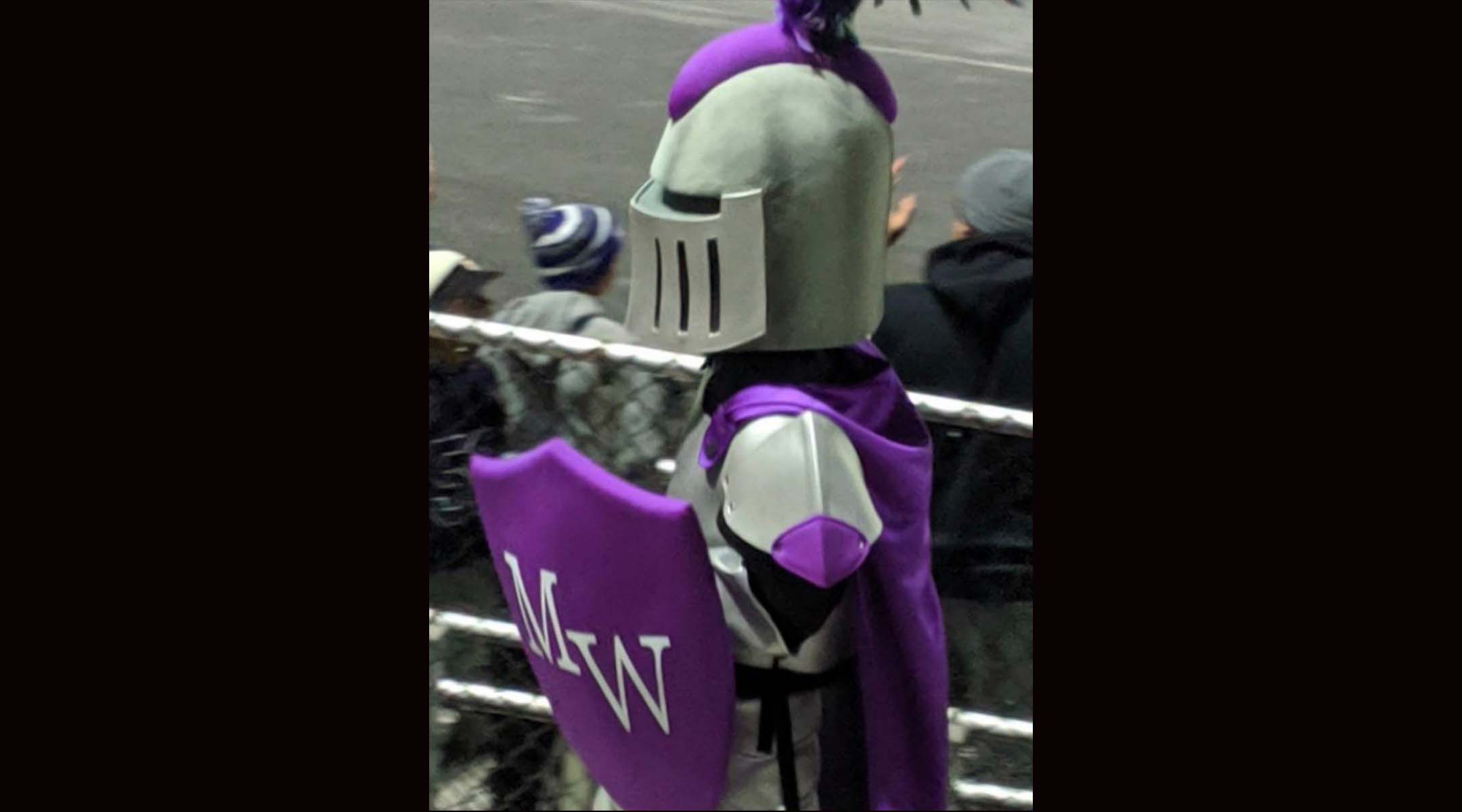This article was produced as part of JTA’s Teen Journalism Fellowship, a program that works with teens across the world to report on issues that impact their lives.
(JTA) — The New Braunfels Unicorns. The Gabbs Tarantulas. The Fisher Bunnies. High school mascots like these may encourage spirit and community, but other schools’ mascots have been called out in recent years for being racist and insensitive, especially to Native Americans and the descendants of the enslaved.
And some mascots can be perceived as antisemitic as well. In 2018, the name of the student publication at Monroe-Woodbury High School in Center Valley, New York was changed from “The Crusader” to “The Wire” when its editorial staff spoke up against what had been the public school’s long-time mascot.
For many Christians, the medieval crusades are associated with European armies’ attempts to recapture the Holy Land and ensure safety for Christian pilgrims visiting sacred sites. And yet they were also occasions for massive outbreaks of antisemitism, like the 1190 massacre of Jews in Norwich near England’s eastern coast. Muslims have complained that glorifying crusaders is Islamophobic.
In their letter to the principal at Monroe-Woodbury High asking for a change, students also noted that the Ku Klux Klan’s official publication is known as “The Crusader.”
“The Ku Klux Klan is a white supremacist organization that uses fear, hatred and violence to achieve its goals; we do not wish to be associated with this group in any way,” the students wrote. “We want our school’s student publication to be a place where all students will feel comfortable sharing their ideas and we would like our publication to be a place where all students feel comfortable reading those ideas.”
Hailey Lanari, a junior at Monroe-Woodbury, says fellow students are ignorant of how Crusaders might be seen as antisemitic. “I don’t think that people are really aware of it,” she said. “I think it kind of just normalizes certain things. I think it just makes it normal for us to be like, ‘Yeah, it was this really bad thing, but it’s ok cause it’s just our school’s mascot.’”
She doesn’t trust that the school would take public steps to address any complaints, and suggests that is why “The Wire” hasn’t written about the mascot in the context of the school. There was, however, a statement released when the paper changed its name.
Out of 231 high schools with “Crusaders” as their mascots, 208 of them are Catholic with little to no Jewish populations, according to MasseyRatings, a mascots database.
Other schools, like the Latin School of Chicago, use “Roman” as their mascot, a reference to the glories of the Roman Empire. But that same empire targeted Jews and destroyed the Second Temple in Jerusalem in 70 C.E. “As someone who finds themselves very involved with the community and plays a lot of sports, it is just something I have come to not enjoy so much,” said Lauren Altman, a student at Latin School and a head of the Jewish Student Connection club.
“Latin School was created to follow this Latin model which is very much about celebrating what is referred to as a Western Civilization,” Latin history teacher Dr. Matthew June said. He argues that the mascot isn’t problematic from a religious standpoint because the two groups clashed politically, not necessarily relating to religion. The destruction of the Second Temple predates the empire’s embrace of Christianity, when attitudes towards Judaism itself became more hostile.
In the past 12 years, 79 schools with Native American mascots across the country changed their mascots, according to The National Congress of American Indians. The NCAI says Native American mascots “remind Native youth of the limited ways in which others see them” and “undermine the ability of Native nations and people to portray themselves accurately as distinct and diverse cultures.”
The mascot of the Lane Tech College Prep High School in Chicago was the “Indian” for over a century before the local school council voted unanimously to change it in the summer of 2020 because of its stereotyping of Native Americans. Prior to the start of the current school year, the school officially rebranded to the Champions.
The Latin School of Chicago adopted its mascot, the Roman, in 1950 based on the suggestion of a sports writer from the Chicago Daily News, according to the school’s archivist, Teresa Sutter. Since then, one of the few conversations about the term occurred nine years ago, when some complained that the symbol was white and gendered.
But those aren’t the only issues with the Roman. The Romans are accused of crucifying Jesus, destroying the Second Temple and turning from a republic to an empire, said Dr. Jeffrey Ellison, a teacher of the Holocaust and the history of antisemitism at Bernard Zell Anshe Emet Day School in Chicago and a former teacher at Latin School. He suggests schools ask themselves, “Is this the symbol that we want to be using to represent us? [The Romans] were just brutal.”
Some mascots, like the Trevians of New Trier Township High School in Winnetka, Il., aren’t seen as obviously offensive, and are not being discussed in schools. The mascot wears the Roman-era costume of a soldier from Trier, a town in present-day Germany where Jews were persecuted by crusaders and ostracized repeatedly beginning as early as the third century.
The mascot and logo of New Trier Township High School in Winnetka, Il., is based on a soldier from Trier, a town in present-day Germany.
“I don’t think anyone’s ever made that connection before,” said Kimberly Hafron, the Hebrew teacher at New Trier. “They’re just this weird mascot.”
Hafron was hesitant to bring the issue to students, because she didn’t want to cause commotion in the community. “I think it would cause one of those ruckus’ where people are like, ‘Oh my God, is there latent antisemitism that we don’t know about?’” she said. “If the people who they could potentially offend don’t have any idea they’re being offended, then the question is, is it offensive?”
For Stella Dale, a Hebrew student at New Trier, the answer is no. “As a Jewish woman, I do not condone antisemitism in any form, but I do think that the mascot itself is not an antisemitic” symbol, Dale, 17, said. “I think that this extension of the Romans destroying the temple is obviously inappropriate, but in my day-to-day life, I really have no hate with the Trevian.”
Overall, because so few students at schools like Monroe-Woodbury and New Trier are aware of the significance of their schools’ mascots, it rarely affects feelings of inclusion at school.
At Latin, however, the Roman mascot does impact a sense of belonging at the school for some Jewish students. Altman said, “If you say you are a Latin Roman, and the Romans did try to kill the Jews, that is going against yourself — saying I am representing somebody who tried to kill my group.”
The Anti-Defamation League has not gotten any reports of discomfort regarding these types of mascots, according to Midwest Regional Director David Goldenberg. “We have spoken out in support of fighting prejudice and discrimination and hurtful stereotypes particularly in the professional sports arena,” Goldenberg said. “We do think it’s important to move away from the use of hurtful and offensive names, mascots and logos.”
The ADL has not, however, taken action regarding mascots like the Crusaders, the Romans, or the Trevians. Because no complaints have been filed on this subject, the ADL has not acted on the matter.
Goldenberg added, “I think one of the things that we are looking [at is] not necessarily the name of a mascot, but we would look at how certain images are adopted by extremist groups or that become extremist symbols.”
“I think there is a real good opportunity to think about what it is that we want to bind us together.” Dr. Ellison said. “What’s that symbol?”



